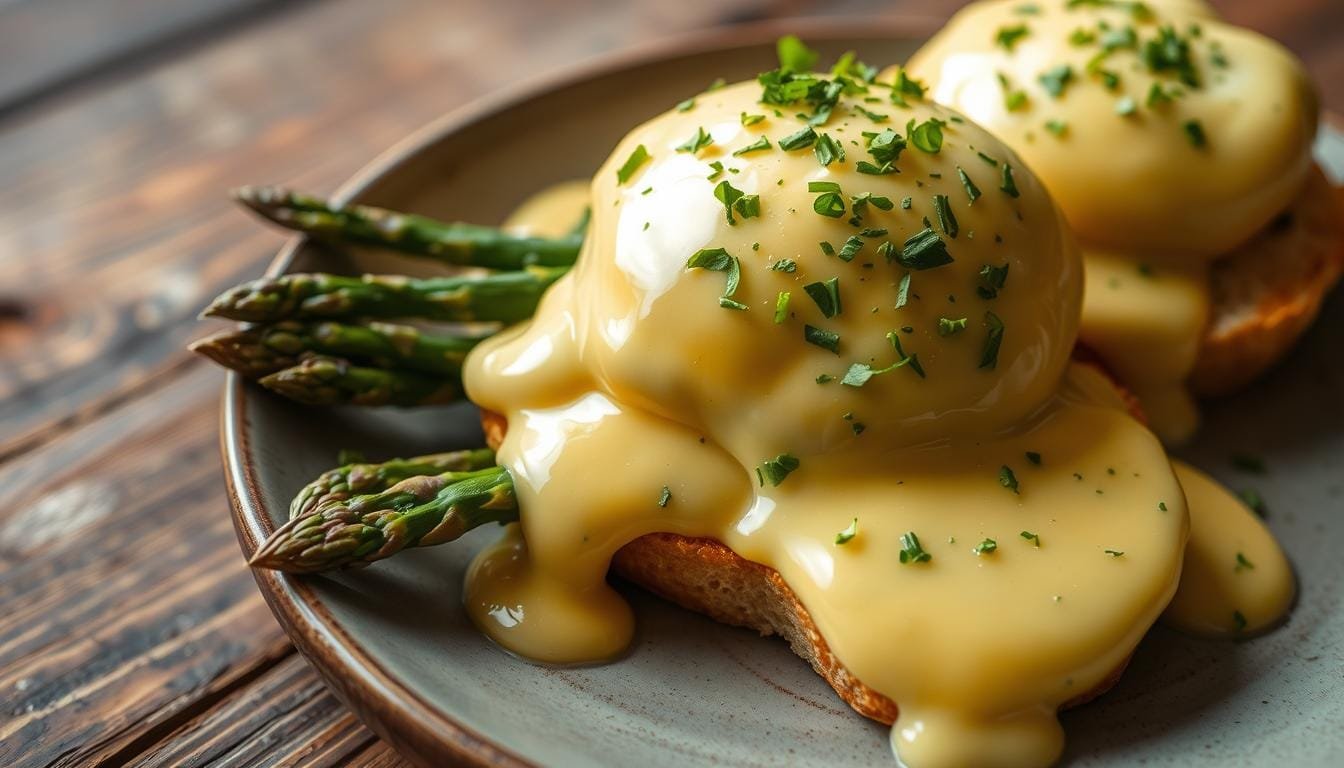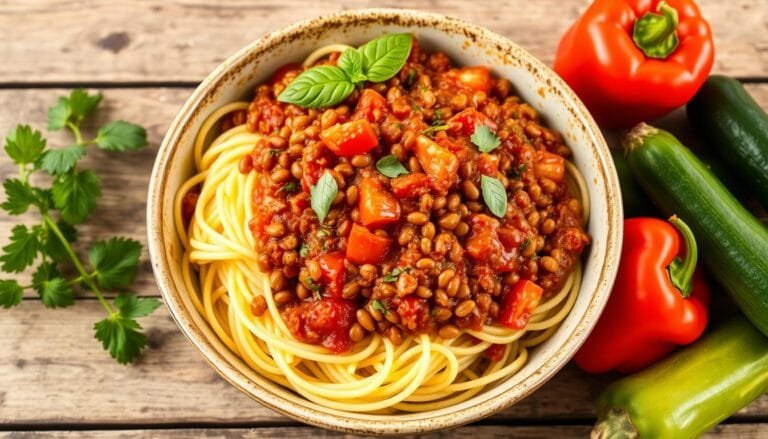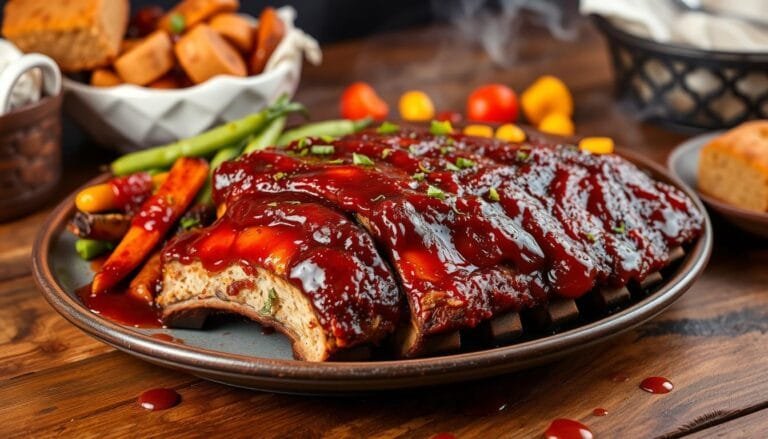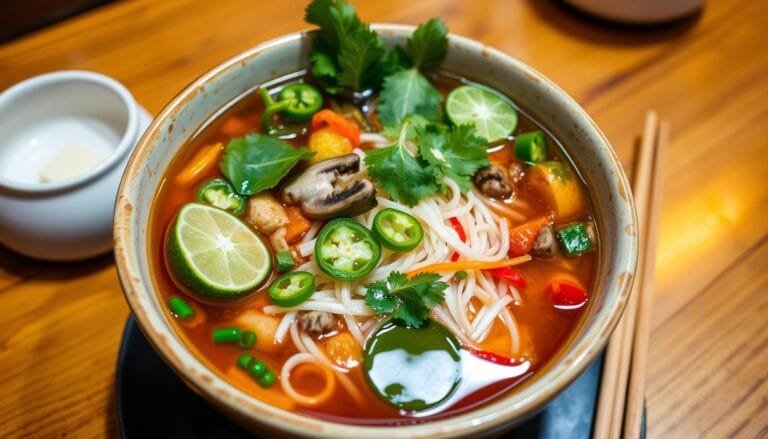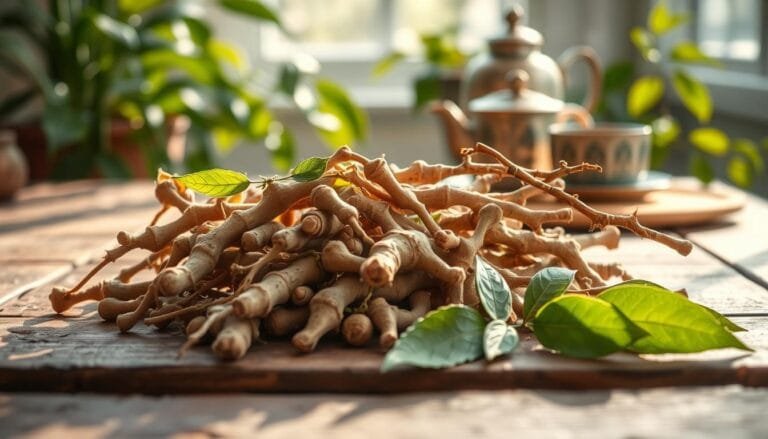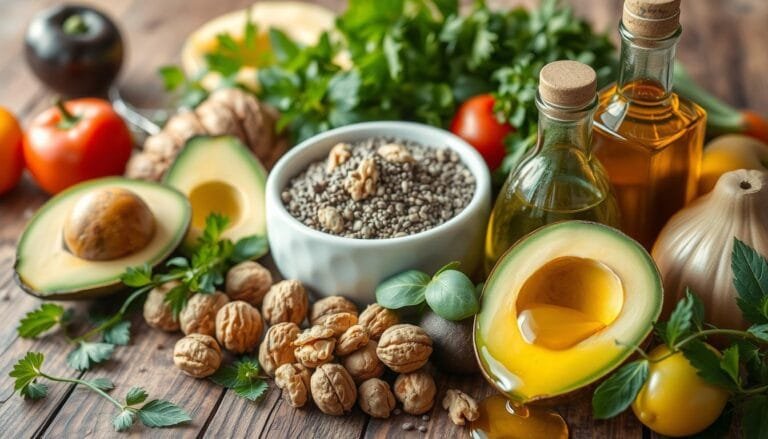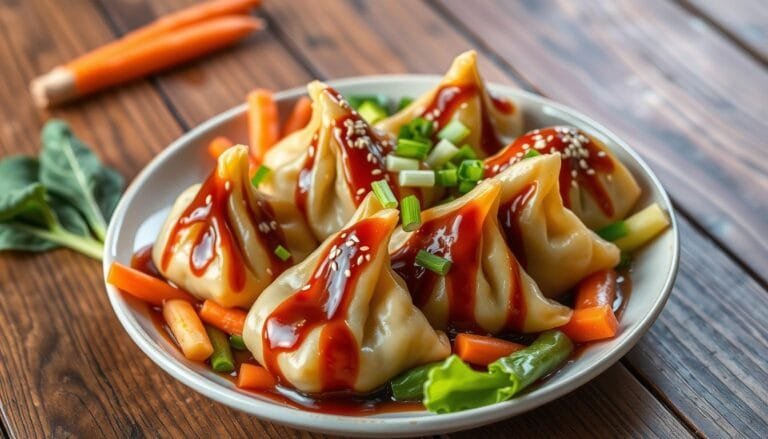I’m excited to share my secrets for a creamy, flavorful, and affordable vegan hollandaise sauce. This version is free from dairy and eggs but keeps the rich taste of the original. It’s also much cheaper and kinder to animals.
Making this sauce is quick and easy. You need just 10 minutes and 9 simple ingredients. It’s great for topping vegan eggs benedict or roasted veggies. The key is a mix of vegan butter, flour, plant milk, kala namak, nutritional yeast, turmeric, black pepper, lemon juice, and mustard powder.
This sauce is a must-try for anyone who eats plant-based or wants to eat less animal products. It’s creamy, rich, and has a hint of lemon. Plus, it tastes like eggs but is much healthier and cheaper.
Understanding Traditional Hollandaise and Its History
The classic hollandaise sauce has a long history, starting in the mid-17th century. It was first found in a 1651 book, Le Cuisinier François, by chef François La Varenne. This sauce, made with egg yolks, melted butter, and lemon juice, is loved by many.
Hollandaise is known for its thick, creamy texture and tangy taste. It’s often used on eggs benedict and steamed asparagus. But, it’s not good for those who don’t eat butter or eggs.
“Hollandaise sauce is one of the French mother sauces, along with its derivative Mayonnaise.”
At one time, people called it “Dutch sauce” because of its French origins. But, by the 20th century, “hollandaise” was the preferred name.
The classic hollandaise sauce has faced challenges with today’s diets. People are looking for vegan and dairy-free versions. This search shows how much we love hollandaise and want to enjoy it in new ways.
The Secret Behind Plant-Based Hollandaise Sauce
Making a tasty vegan hollandaise sauce is simpler than you might think. Just a few plant-based ingredients can make a creamy, flavorful sauce. It’s as good as the traditional one. Let’s explore how to make this vegan delight.
Essential Base Ingredients
The base of a great vegan hollandaise is soft tofu or cauliflower purée, plant-based milk, and olive oil. These ingredients mix to make a smooth, creamy base. It’s very close to the real thing.
Key Flavor Components
- Nutritional yeast: This adds a cheesy flavor, just like the original sauce.
- Lemon juice and zest: Fresh lemon juice and zest give a tangy taste that balances the creaminess.
- Mustard: A bit of Dijon or whole-grain mustard adds to the flavor.
- Soy sauce: A little soy sauce or tamari brings out the umami.
- Turmeric: A pinch of turmeric makes the sauce golden.
Optional Enhancers
To make your vegan hollandaise even better, try these optional ingredients:
- Onion powder: A bit of onion powder adds depth to the flavor.
- Garlic powder: A sprinkle of garlic powder can make it taste even better.
- Black salt (kala namak): This salt gives an “eggy” taste, just like the original.
- Cayenne pepper: A pinch of cayenne pepper adds a nice kick.
You can adjust the sauce’s thickness by adding more or less plant-based milk.
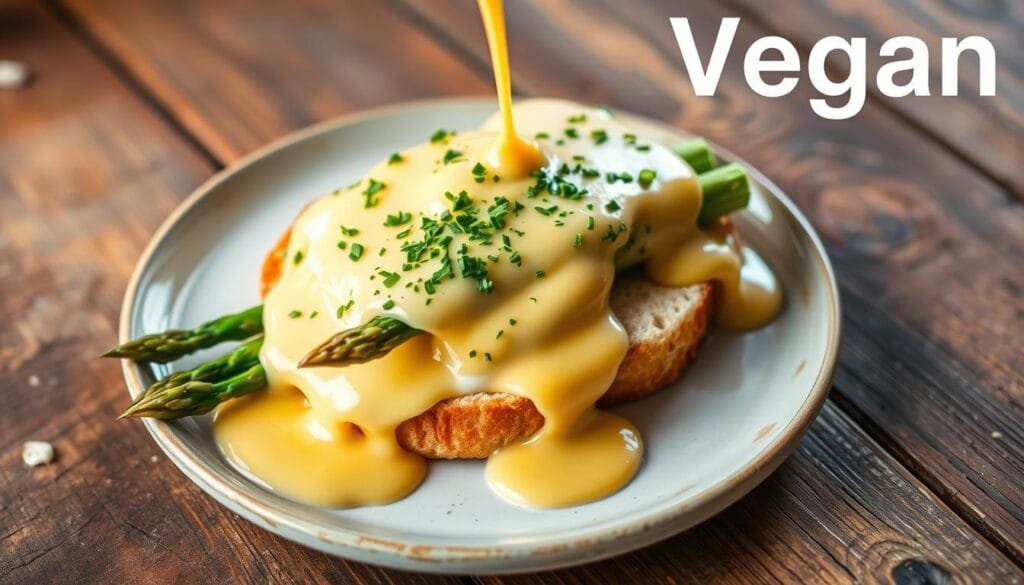
“With a few simple swaps, you can create a vegan hollandaise sauce that is just as creamy, tangy, and flavorful as the original.”
Why This Vegan Version Beats Traditional Hollandaise
The vegan version of hollandaise sauce has a big edge over the traditional one. It’s simpler to make and doesn’t risk a broken emulsion. Plus, it’s lighter and healthier, using basic ingredients from your pantry.
The vegan hollandaise sauce is very versatile. Unlike the classic version, which depends on eggs and butter, this sauce can fit many diets. It’s cholesterol-free and has fewer calories and fat than the traditional recipe.
- Easier to make with no risk of broken emulsions
- Lighter and healthier than the classic version
- Uses simple, inexpensive pantry ingredients
- Suitable for vegan, dairy-free, and egg-free diets
- No cholesterol and lower in calories and fat
This vegan hollandaise is a big deal in the sauce world. It’s a tasty and healthy choice compared to the traditional recipe. It’s perfect for anyone wanting to try a plant-based lifestyle.
“This vegan hollandaise sauce is a revelation! It’s so easy to make and tastes just as rich and creamy as the traditional version, but without the guilt.”
Plant-based Hollandaise: A Step-by-Step Method
Making vegan hollandaise sauce at home is simple. Just a few steps can create a creamy, flavorful sauce. It’s as good as the egg-based version. Let’s explore how to make the perfect vegan hollandaise sauce.
Preparing Your Base
First, get your ingredients ready. You’ll need raw cashews, nutritional yeast, lemon juice, and more. Put them all in a high-speed blender. Blend until it’s smooth and creamy.
Blending Techniques
Use a strong blender for the best texture. The fast blending mixes the ingredients well. Blend for a minute or two, stopping to scrape the sides. This will make it silky and velvety.
Achieving Perfect Consistency
To change the sauce’s thickness, add plant-based milk. Start with a little and add more as needed. Warm it gently in a saucepan, stirring often. This keeps it smooth. Season with salt, pepper, or other flavors to taste.
With these steps, you can make a vegan hollandaise recipe quickly and easily. Enjoy it on breakfast dishes or with veggies. Your plant-based sauce method and blending vegan sauce will be a hit.

Essential Equipment for Perfect Vegan Hollandaise
To make a creamy vegan hollandaise sauce, you need some key kitchen tools. A high-speed blender or food processor is the base. It makes the sauce smooth.
A small saucepan is vital for warming the sauce gently. This prevents it from curdling or separating. A whisk is also essential for mixing the ingredients well.
Having your measuring cups and spoons ready is important. They help you measure ingredients accurately. For even heating, a double boiler setup is a good choice.
| Essential Equipment | Purpose |
|---|---|
| High-speed blender or food processor | Blends ingredients into a creamy, smooth consistency |
| Small saucepan | Gently warms the sauce without direct heat |
| Whisk | Incorporates and mixes the ingredients |
| Measuring cups and spoons | Ensures accurate ingredient proportions |
| Optional: Double boiler | Provides gentle, even heating for the sauce |
With these vegan sauce tools and plant-based sauce equipment, you’re set. You’ll make a silky, flavorful vegan hollandaise sauce that’s just as good as the original.
The Role of Nutritional Yeast in Vegan Sauces
Nutritional yeast is key in making tasty plant-based sauces. It gives a savory, “cheesy” taste that makes vegan hollandaise and other dairy-free sauces better. But it does more than just add flavor.
Nutritional Benefits
Nutritional yeast is full of important nutrients, like B vitamins. Two tablespoons can give you a big part of your daily B12. This is great for vegans and vegetarians who need to get enough B12.
Flavor Enhancement Properties
Nutritional yeast has a rich umami taste that’s perfect for vegan sauces. It makes our plant-based hollandaise creamy and gives it a golden color, just like the real thing.
Adding a few tablespoons of nutritional yeast to your vegan sauce recipes can really improve the taste. It’s a must-have for anyone who loves cooking with dairy-free ingredients.
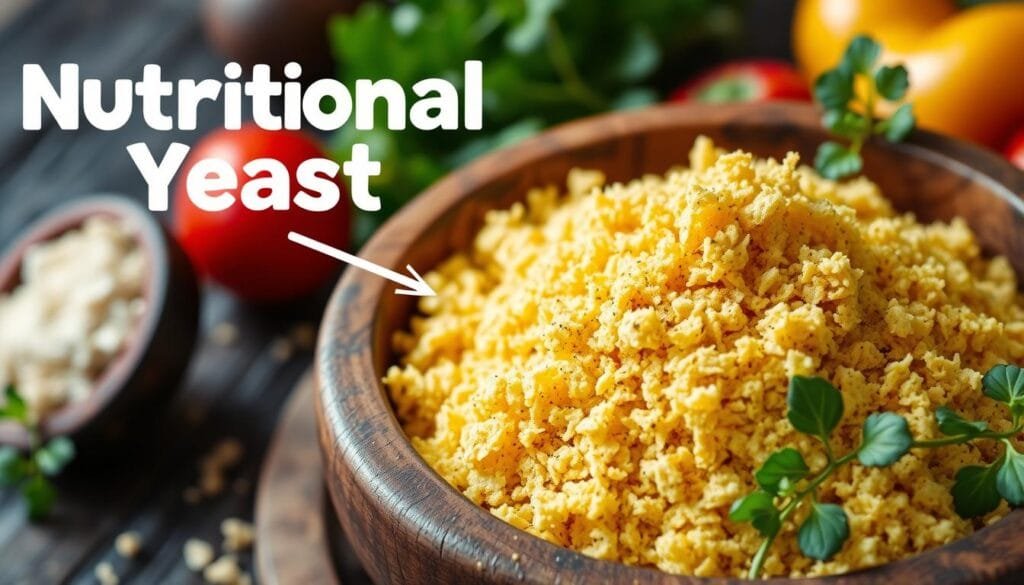
“Nutritional yeast is a game-changer for vegan cooking, adding a savory, cheese-like flavor that satisfies cravings without any dairy.”
Troubleshooting Common Sauce Issues
Making the perfect vegan sauce can be tricky, but I’m here to help! Whether you’re making creamy plant-based hollandaise or other savory sauces, these tips will solve any vegan sauce problems.
Fixing a Thick Sauce
If your vegan sauce is too thick, add a bit of your favorite plant-based milk. Blend or whisk until it’s just right.
Thinning a Runny Sauce
Is your plant-based hollandaise too thin? Mix in some soft tofu or cauliflower purée. This will thicken it without losing flavor.
Enhancing Flavor
Want more flavor in your vegan sauce? Add more nutritional yeast for a cheesy taste or a squeeze of lemon for tanginess.
Preventing Separation
Is your plant-based hollandaise separating? Just blend or whisk it again to fix it.
Smoothing Out Texture
Got a grainy texture? Blend your vegan sauce well. Strain it through a fine-mesh sieve for a smooth finish.
Reheating Considerations
When reheating plant-based hollandaise, warm it slowly. Add plant-based milk if it gets too thick.
With these tips, you’ll make perfect plant-based hollandaise in no time. Happy cooking!
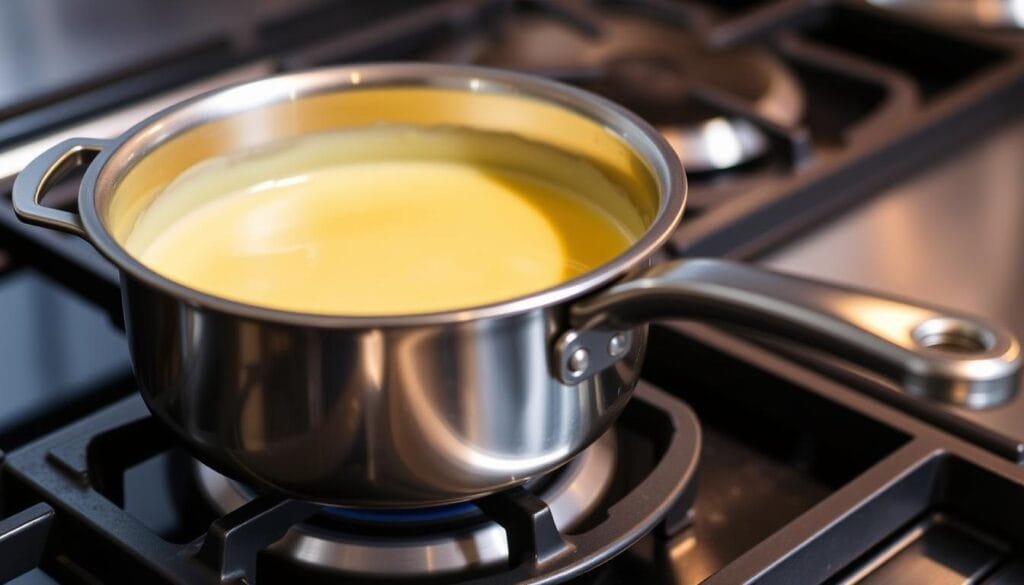
Creative Ways to Serve Your Vegan Hollandaise
Discover the many uses of your homemade vegan hollandaise sauce! It can make any dish, from breakfast to main courses, taste amazing. Let’s look at some tasty ways to use this creamy sauce in your cooking.
Breakfast Applications
Begin your day with a luxurious touch by pouring vegan hollandaise over tofu scramble or vegan eggs benedict. The sauce’s rich taste goes well with eggs. It’s also great as a dip for breakfast potatoes or hashbrowns for a special treat.
Vegetable Pairings
Make your roasted, grilled, or sautéed veggies even better with vegan hollandaise. It’s perfect with asparagus, broccoli, artichokes, and spinach. The sauce adds a creamy touch that brings out the veggies’ natural flavors.
Main Course Ideas
Vegan hollandaise is great for more than just breakfast. Try it on vegan patties, zucchini fritters, falafels, tofu steaks, or tempeh slices for a rich meal. There are countless ways to enjoy it!
Feel free to try new things with vegan hollandaise uses and plant-based sauce pairings. Add it to breakfast burritos, tacos, or enchiladas for a tasty twist. It’s also great as a dip for roasted veggies. The possibilities are endless with this versatile sauce.
Storage Tips and Reheating Methods
Keeping your homemade vegan hollandaise sauce fresh is important. With a few easy steps, you can enjoy it for days. This plant-based delight is sure to please.
To store your vegan hollandaise sauce, put it in an airtight container. Then, refrigerate it for up to 5 days. Remember, it might thicken in the fridge. But, it’s easy to fix. Just reheat it gently on the stovetop or in the microwave, stirring often.
If it gets too thick, add some plant-based milk. Stir well before serving. This will help it return to its creamy state.
Vegan hollandaise sauce should not be frozen. Freezing can change its texture, affecting its quality. For the best taste, make fresh batches as you need them.
| Storage Method | Duration | Reheating Tip |
|---|---|---|
| Refrigerator | Up to 5 days | Gently reheat on stovetop or in microwave, adding a splash of plant milk to thin if needed |
| Freezer | Not recommended | N/A |
By following these storage and reheating guidelines, you can enjoy your homemade vegan hollandaise sauce for days. Its creamy, indulgent flavor will be ready whenever you want it.
Cost Comparison: Traditional vs. Vegan Hollandaise
As someone who loves healthy food, I’ve noticed more people choosing plant-based options. Vegan hollandaise sauce is a great example. It’s cheaper than the traditional version made with butter and eggs. Let’s see how much you can save with vegan hollandaise.
A homemade vegan sauce cost for 1 cup of plant-based hollandaise is about $1.30 CAD. The traditional version, with 1/2 cup of butter and 3 eggs, costs around $3.15 CAD. That’s a big plant-based hollandaise savings of almost $2 per batch!
| Ingredient | Traditional Hollandaise | Vegan Hollandaise |
|---|---|---|
| Butter | $2.50 (1/2 cup) | – |
| Eggs | $0.65 (3 eggs) | – |
| Water | – | $0.01 (1 cup) |
| Flax Seeds | – | $0.15 (2 tbsp) |
| Nutritional Yeast | – | $0.40 (1-1.5 tsp) |
| Lemon Juice | – | $0.24 (2 tbsp) |
| Dijon Mustard | – | $0.10 (1/2 tsp) |
| Spices | – | $0.10 (1/4 tsp) |
| Oil | – | $0.30 (2/3 cup) |
| Total Cost | $3.15 | $1.30 |
The vegan version is cheaper because it uses flax seeds, nutritional yeast, and oil. These are more affordable than dairy and eggs. Buying these ingredients in bulk can save even more money.
If you want to save money and enjoy a tasty hollandaise sauce, try the vegan version. It’s not only cheaper but also better for the planet.
Health Benefits of Plant-Based Alternatives
Plant-based hollandaise sauce is becoming more popular. It’s great for those who follow special diets. This vegan version is not only good for dietary needs but also has more health benefits than the traditional egg-based sauce.
Nutritional Profile
Plant-based hollandaise sauce has fewer calories and less fat than the traditional version. It’s also cholesterol-free, which is good for heart health. It has B vitamins from nutritional yeast and protein from tofu or plant-based milk.
Dietary Advantages
- Suitable for vegan, dairy-free, and egg-free diets
- Can be made gluten-free with appropriate substitutions
- Rich in anti-inflammatory properties from ingredients like turmeric
- Provides essential nutrients without the saturated animal fats found in traditional hollandaise
Choosing plant-based hollandaise sauce lets you enjoy a creamy, indulgent taste. It’s a healthier and more sustainable choice. It’s perfect for those who want to eat well or follow specific diets.
Seasonal Variations and Flavor Adaptations
I’m a plant-based chef who loves making traditional recipes vegan. My vegan hollandaise sauce is great because it can change with the seasons. It lets me use fresh ingredients and make flavors pop for any event.
In spring, I add fresh herbs like dill or chives for a bright taste. Summer brings basil or tarragon for a fresh burst. Fall and winter get earthy with sage or thyme. And for a treat, roasted garlic or truffle oil add a rich flavor.
Want something spicy? Add more cayenne pepper or chipotle for a smoky kick. For a green twist, I mix in parsley, cilantro, or tarragon. Or, swap lemon juice for orange or lime for a citrusy flavor.
FAQ
What are the key ingredients in this easy vegan hollandaise sauce?
How long does it take to prepare the vegan hollandaise sauce?
What are the key differences between traditional hollandaise and this vegan version?
What are the benefits of the plant-based hollandaise sauce?
How do I achieve the perfect consistency for the vegan hollandaise sauce?
What equipment is needed to make the vegan hollandaise sauce?
What is the role of nutritional yeast in this vegan sauce?
How can I troubleshoot any issues with the vegan hollandaise sauce?
How can I serve the vegan hollandaise sauce?
How should I store and reheat the vegan hollandaise sauce?
How does the cost of the vegan hollandaise sauce compare to the traditional version?
FAQ
What are the key ingredients in this easy vegan hollandaise sauce?
This vegan hollandaise sauce has just a few ingredients. You’ll need vegan butter, flour, plant milk, kala namak, nutritional yeast, turmeric, black pepper, lemon juice, and mustard powder.
How long does it take to prepare the vegan hollandaise sauce?
You can make this easy vegan hollandaise sauce in 10 minutes. It’s quick and easy to prepare.
What are the key differences between traditional hollandaise and this vegan version?
Traditional hollandaise uses egg yolks, melted butter, and lemon juice. The vegan version uses soft tofu or cauliflower, plant milk, and olive oil. It also includes nutritional yeast, lemon, mustard, and other flavor enhancers.
What are the benefits of the plant-based hollandaise sauce?
The vegan hollandaise sauce is lighter and healthier than the traditional version. It’s also lower in calories and fat, and doesn’t contain cholesterol. It’s perfect for vegan, dairy-free, and egg-free diets.
How do I achieve the perfect consistency for the vegan hollandaise sauce?
To get the right consistency, adjust the amount of plant-based milk. Warm the sauce gently over low heat, stirring often, to keep it smooth.
What equipment is needed to make the vegan hollandaise sauce?
You’ll need a high-speed blender or food processor for a smooth texture. A small saucepan, whisk, and measuring cups are also necessary. A double boiler helps warm the sauce without direct heat.
What is the role of nutritional yeast in this vegan sauce?
Nutritional yeast gives the sauce a cheesy flavor. It’s rich in B vitamins, including B12, and adds umami taste and a creamy texture. It also makes the sauce golden.
How can I troubleshoot any issues with the vegan hollandaise sauce?
If the sauce is too thick, add more plant-based milk. If it’s too thin, blend in more tofu or cauliflower purée. Adjust the seasoning if needed. Re-blend or whisk vigorously if it separates. Strain to fix a grainy texture.
How can I serve the vegan hollandaise sauce?
You can use the sauce on vegan eggs benedict, tofu scramble, breakfast potatoes, or hashbrowns. It’s also great with steamed or roasted vegetables, vegan patties, zucchini fritters, falafels, tofu steaks, and tempeh slices. Try it as a dipping sauce or topping for breakfast burritos, tacos, or enchiladas.
How should I store and reheat the vegan hollandaise sauce?
Store it in an airtight container in the fridge for up to 5 days. Reheat gently on the stovetop or in the microwave, adding plant milk if needed. Stir well before serving. Don’t freeze it as the texture may change.
How does the cost of the vegan hollandaise sauce compare to the traditional version?
The vegan version is much cheaper, costing about
FAQ
What are the key ingredients in this easy vegan hollandaise sauce?
This vegan hollandaise sauce has just a few ingredients. You’ll need vegan butter, flour, plant milk, kala namak, nutritional yeast, turmeric, black pepper, lemon juice, and mustard powder.
How long does it take to prepare the vegan hollandaise sauce?
You can make this easy vegan hollandaise sauce in 10 minutes. It’s quick and easy to prepare.
What are the key differences between traditional hollandaise and this vegan version?
Traditional hollandaise uses egg yolks, melted butter, and lemon juice. The vegan version uses soft tofu or cauliflower, plant milk, and olive oil. It also includes nutritional yeast, lemon, mustard, and other flavor enhancers.
What are the benefits of the plant-based hollandaise sauce?
The vegan hollandaise sauce is lighter and healthier than the traditional version. It’s also lower in calories and fat, and doesn’t contain cholesterol. It’s perfect for vegan, dairy-free, and egg-free diets.
How do I achieve the perfect consistency for the vegan hollandaise sauce?
To get the right consistency, adjust the amount of plant-based milk. Warm the sauce gently over low heat, stirring often, to keep it smooth.
What equipment is needed to make the vegan hollandaise sauce?
You’ll need a high-speed blender or food processor for a smooth texture. A small saucepan, whisk, and measuring cups are also necessary. A double boiler helps warm the sauce without direct heat.
What is the role of nutritional yeast in this vegan sauce?
Nutritional yeast gives the sauce a cheesy flavor. It’s rich in B vitamins, including B12, and adds umami taste and a creamy texture. It also makes the sauce golden.
How can I troubleshoot any issues with the vegan hollandaise sauce?
If the sauce is too thick, add more plant-based milk. If it’s too thin, blend in more tofu or cauliflower purée. Adjust the seasoning if needed. Re-blend or whisk vigorously if it separates. Strain to fix a grainy texture.
How can I serve the vegan hollandaise sauce?
You can use the sauce on vegan eggs benedict, tofu scramble, breakfast potatoes, or hashbrowns. It’s also great with steamed or roasted vegetables, vegan patties, zucchini fritters, falafels, tofu steaks, and tempeh slices. Try it as a dipping sauce or topping for breakfast burritos, tacos, or enchiladas.
How should I store and reheat the vegan hollandaise sauce?
Store it in an airtight container in the fridge for up to 5 days. Reheat gently on the stovetop or in the microwave, adding plant milk if needed. Stir well before serving. Don’t freeze it as the texture may change.
How does the cost of the vegan hollandaise sauce compare to the traditional version?
The vegan version is much cheaper, costing about $1.30 CAD for 1 cup. The traditional version would cost around $3.15 CAD for the main ingredients. The vegan version uses affordable pantry staples instead of expensive dairy and eggs.
.30 CAD for 1 cup. The traditional version would cost around .15 CAD for the main ingredients. The vegan version uses affordable pantry staples instead of expensive dairy and eggs.
